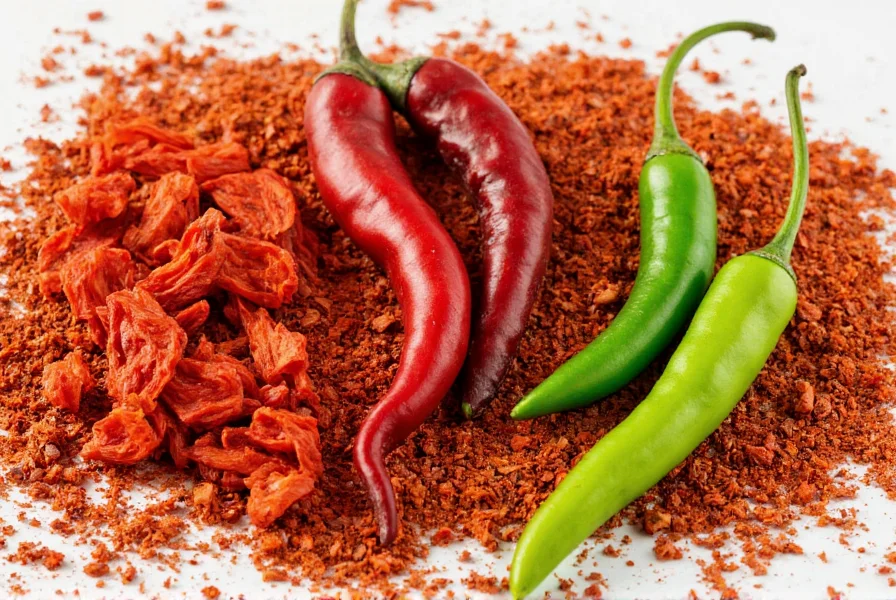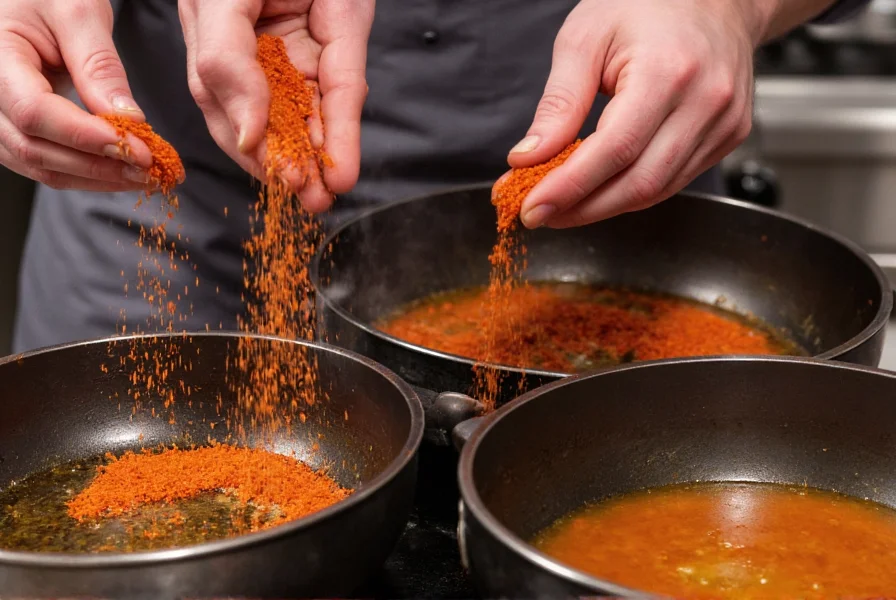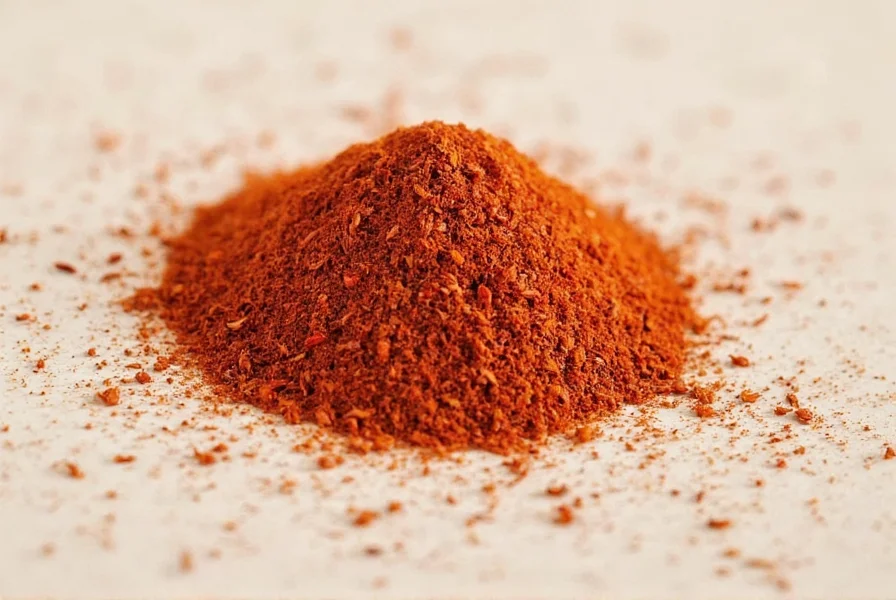Running out of red pepper flakes mid-recipe can derail your cooking plans, but several effective substitutes exist that maintain your dish's intended flavor profile. Understanding the unique characteristics of red pepper flakes helps identify the most appropriate alternatives for different culinary situations.
Understanding Red Pepper Flakes Characteristics
Red pepper flakes consist of dried and crushed cayenne peppers, typically ranging from 30,000 to 50,000 Scoville Heat Units. Their distinctive qualities include:
- Medium heat level with gradual build-up
- Subtle fruity undertones beneath the spice
- Dry texture that integrates well into sauces and dry rubs
- Visual appeal with vibrant red specks throughout dishes
Top 7 Practical Substitutes for Red Pepper Flakes
| Substitute | Conversion Ratio | Heat Level | Best For |
|---|---|---|---|
| Cayenne pepper | 1:2 (1/4 tsp cayenne = 1/2 tsp flakes) | Higher, more immediate heat | Sauces, marinades, dry rubs |
| Crushed dried arbol chilies | 1:1 | Similar heat, brighter flavor | Pizza, pasta, Mediterranean dishes |
| Fresh serrano peppers | 1:1 (finely chopped) | Similar heat, fresher profile | Salsas, stir-fries, fresh sauces |
| Hot sauce (Tabasco) | 1/2 tsp per 1/2 tsp flakes | Similar heat, adds liquid | Marinades, soups, braises |
| Smoked paprika | 1:1 | Much milder, smoky depth | Stews, roasted vegetables, mild dishes |
| Crushed dried guajillo chilies | 1:1 | Milder, earthy flavor | Mexican cuisine, complex sauces |
| Black pepper + pinch cayenne | 1/2 tsp black pepper + 1/8 tsp cayenne | Adjustable heat level | When you need texture without intense heat |
How to Choose the Right Replacement for Your Recipe
Selecting the ideal substitute depends on your specific culinary context. Consider these factors when determining which replacement for red pepper flakes works best for your dish:
Recipe Type Considerations
For Italian dishes like pizza or pasta sauces, crushed dried arbol chilies provide the closest flavor match. Their bright, slightly fruity heat mimics traditional red pepper flakes without overwhelming other ingredients. When making Asian-inspired dishes, fresh serrano or Thai bird chilies offer better flavor compatibility than cayenne powder.

Heat Level Adjustments
Understanding the Scoville scale differences prevents over-spicing. Cayenne powder measures 30,000-50,000 SHU compared to red pepper flakes' 25,000-35,000 range. When substituting cayenne for red pepper flakes, start with half the amount and adjust to taste. For milder dishes, smoked paprika (1,000-2,000 SHU) provides color and depth without significant heat.
Texture and Visual Impact
Red pepper flakes add distinctive red specks to dishes. When appearance matters, crushed dried chilies maintain this visual element better than powders. For smooth sauces where texture matters less, cayenne or paprika integrates more seamlessly. In baking applications, finely ground substitutes work best to avoid unpleasant mouthfeel.
Practical Substitution Techniques
Successful replacement for red pepper flakes requires more than simple ingredient swapping. Follow these professional techniques for optimal results:
Timing Matters
Add dry substitutes like cayenne or paprika early in cooking to allow flavors to meld. Introduce fresh chili peppers toward the end of cooking to preserve their bright flavor. When using hot sauce as a red pepper flakes alternative, incorporate it during the final 5-10 minutes to maintain its distinctive vinegar notes.
Building Flavor Complexity
For dishes where red pepper flakes provide both heat and depth, combine substitutes for better results. Try smoked paprika with a pinch of cayenne to replicate the complex flavor profile. In tomato-based sauces, add a small piece of dried chili along with your substitute to enhance depth without excessive heat.

Adjusting for Liquid Content
When substituting hot sauce for red pepper flakes, reduce other liquids in your recipe by 1-2 teaspoons per teaspoon of hot sauce added. For oil-based recipes like salad dressings, consider chili-infused oil as a replacement that maintains the proper oil-to-acid ratio while delivering heat.
Common Substitution Mistakes to Avoid
Even experienced cooks make errors when seeking alternatives to red pepper flakes. Watch for these pitfalls:
- Overcompensating with heat - Remember that cayenne is significantly hotter than most red pepper flakes blends
- Ignoring flavor profiles - Chipotle powder adds smokiness that may not suit Italian recipes
- Adding substitutes at the wrong time - Delicate fresh chilies lose flavor when cooked too long
- Not tasting as you go - Heat perception varies between substitutes; adjust incrementally
Specialized Substitution Scenarios
Certain cooking situations require tailored approaches when replacing red pepper flakes:
For Gluten-Free and Special Diets
Many commercial red pepper flakes contain anti-caking agents that may not suit strict dietary requirements. When seeking a gluten-free replacement for red pepper flakes, make your own by drying and crushing pure cayenne peppers or using single-ingredient alternatives like pure cayenne powder.
In Baking Applications
For recipes like spicy chocolate or gingerbread that call for red pepper flakes, use a combination of cinnamon and cayenne (1/4 tsp cinnamon + 1/8 tsp cayenne per 1/2 tsp flakes) to maintain both heat and the subtle fruitiness that flakes provide in baked goods.
For Large-Batch Cooking
When scaling up recipes, remember that heat perception isn't linear. If substituting cayenne for red pepper flakes in a large pot of sauce, use only 75% of the calculated amount initially, then adjust upward. The human palate perceives heat differently in larger quantities.











 浙公网安备
33010002000092号
浙公网安备
33010002000092号 浙B2-20120091-4
浙B2-20120091-4